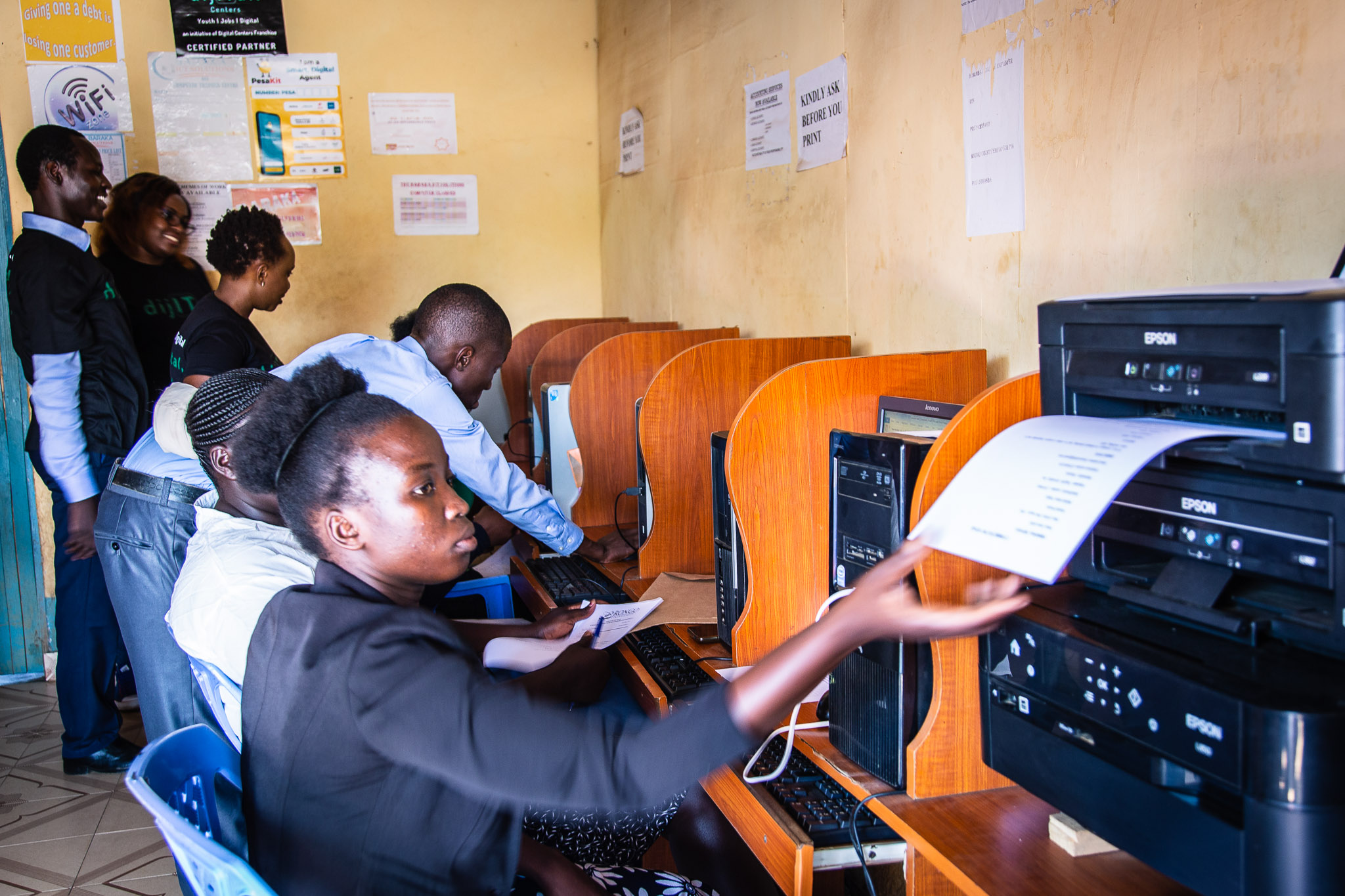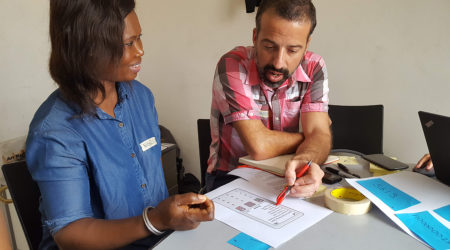Bridging the digital divide: using technology to adapt to COVID-19

While the number of mobile users in Kenya stands at over 20 million, only 1 in 5 users has access to the internet, meaning that a large portion of the country’s population is still offline. A large segment of this population relies on cyber cafes for basic online activities, like checking their email and accessing e-government services such as renewal of licenses and filing returns. Cyber cafes are essential to closing the digital divide and helping individuals and businesses use the internet more productively. However, in a world that is increasingly digital and smartphone-driven, will cyber cafes be dismissed as a relic of the past, or will they continue to act as a gateway to the future?
The changing role of cyber cafes in the digital economy
In the early 2000’s, the cybercafe (also known as internet cafe) business model in Kenya saw significant growth as more users were looking to get online. However, data remained expensive and access to devices a challenge. Over the last 22 years, the price of data has gone from monthly dial-up rates of US$72 (with an additional US$5/hour and an installation fee of US$20) down to US$1.05/GB for mobile internet, making access much more ubiquitous. Revenues for internet access have also dropped significantly, from US$12 to US$0.6 per hour, across the same period. Therefore it is no wonder that most cybercafes have faced challenges, with ventures closing as they are unable to keep up with the competition and increasingly low margins. Furthermore, the portion of in-demand services predominantly accessed by moderate to heavy users (most of whom happen to be youth) are now easily accessible on smartphones.
Traditionally, cybercafes provided a gateway to the internet as the go-to location for Kenyans who wanted assistance navigating the online world – whether it was using and sending emails or creating social media profiles. In subsequent years, the number of people who needed basic support to get online significantly reduced. On the flip side, however, people began using the internet for a more diverse range of activities, from applying for jobs, to upskilling via online courses, pursuing online gig work, gaming, e-commerce, e-learning and more. Individuals began launching their own businesses or hustles, each requiring a range of digital support services, from registration, to websites, to branded materials.
To access these services, aspiring internet users found more reasons to use a desktop and sought the support of cybercafe attendants, capitalizing on the relationships they had already built when they first encountered the online world. Other catalysts, including progress made by the Kenyan government in digitizing immigration and tax services such as e-citizen and KRA, provided additional revenue streams for cybercafes, further reinforcing their role in the digital economy.
The future of digital in combating youth unemployment
In Africa, one-third of the 420 million youth (aged 15-35) are unemployed, another third are in vulnerable employment and only one in six is in wage employment. Each year, 10 to 12 million youth enter Africa’s workforce, while only about 3.1 million formal sector jobs are created. While many approaches that aim to give African youth inclusive access to jobs and upward mobility have been tested, only a few models have had a significant impact in minimizing youth unemployment on the continent. The most viable option for youth today is often self-employment or digital gig work. Across Kenya, young people have opened cyber cafes to create employment opportunities and to provide access to digital products and services for people excluded via traditional channels.
In 2020, Digital Data Divide, together with BFA Global and in partnership with the IKEA Foundation, launched Dijitali, a program designed to determine whether cybercafes in Kenya can evolve to become holistic digital centers for the communities they serve, creating jobs and enabling greater access to online services, in a bid to remain relevant in today’s increasingly digital landscape.
The Digital Centers project was launched in March 2020 as a model to increase digital inclusion, create jobs and increase the revenues of cybercafes. Over the span of one year, we have built a fully digital network, recruited 270 cybercafes across the country, created 64 new jobs and launched 15 fully equipped centers. Our goal is to understand whether cybercafes can continue to grow via a new business model through which they offer more than just access to the internet – including media, design, e-commerce and print services, via fully trained staff. The program recorded all around revenue increases within our network, with some centers registering 200% revenue growth.
As we validated this new business model, we partnered with organizations and B2B partners that were interested in expanding their geographical footprint without the related expenses that come with launching physical offices.
The impact of the COVID-19 pandemic
Then, COVID-19 happened.
For many small businesses, the pandemic exposed the vulnerability of their brick and mortar status and overreliance on traditional routes to market. Cyber cafes were no different. For some in our network, COVID-19 brought an unexpected glimmer of hope at a time when most micro and small enterprises (MSEs) were struggling to stay afloat. As lockdown measures increased, rather than facing a downturn in foot traffic as expected, we instead started seeing cybercafes take on increasingly diverse and critical roles across the country.
Pam, who operates a cyber cafe in Busia, spent a large part of May to August 2020 helping parents and their children navigate online calls and e-learning. In the central region, we found cybercafes initiating B2B partnerships with SACCOs, banks and insurance companies. And across the country, these cybercafes were helping schools navigate printing and distribution of students’ homework, learner registration, teacher appraisals, assessments and generally acting as a hub for online education needs.
We came to the realization that these MSEs were no longer reliant only on those who came in looking to surf the internet, nor were their revenues dependent only on walk-in clients. They had quickly pivoted and diversified their offerings to appeal to a larger cross-section of clientele, and were playing the role of bona fide digital translators for their communities, including educational institutions, county governments and other businesses. In light of this, we stopped referring to them as cybercafes and renamed them dijITali Centers to reflect the expanded scope of services they were now offering.
As we grappled with the question of how to best support this digital network, we kept running into some major challenges. For instance, internet solutions remained expensive for low-margin businesses, and they faced infrastructure challenges like frequent electricity blackouts. Thus, the resurrection of cybercafes seemed to be short-lived.
However, we knew there was a solution. To re-imagine the future potential of these centers, it is important to understand the role that they would play as digital translators.
Re-imagining the role of digital centers
To serve this increasingly diverse set of needs, cybercafe attendants needed to become experts in a range of digital services, quickly. We considered what other adjacent services could potentially be offered by these new ‘digital centers.
35 centers participated in our customized, experiential Design by dijITali course, to learn additional skills such as logo design, branding development and large format printing for different businesses across the country, alongside design of funeral and wedding invitations, banners and most recently, customized birthday and success cards. Seven centers applied and qualified for financing to build fully kitted dijITali Print Centers that give them the capacity to print high-quality, large-scale merchandise (t-shirts, hats, mugs, banners).
Six dijITali Media Centers, after learning how to do video and photo editing for their clients, decided they wanted to expand further. So we developed a financing package for a complete studio setup, with professional studio lights, high-resolution cameras and printers. Those cafes that received this financing have now become full-fledged entertainment centers, live-streaming events in the era of social distancing and lockdowns.
Additionally, gaming centers are expanding their remit beyond traditional online gaming, to explore virtual gaming and virtual tournaments. Those dijITali centers that already offered basic training have expanded to bring more relevant skills to the job seekers in their communities and are rolling out computer networking, coding, app development and data science courses.
Our work has just begun, but the possibilities are endless. If there is one thing we are sure of, it is that with the right kind of support and engagement, our dijITali Centers have the potential to develop into lasting enterprises, ushering in the next era of community-based digital access and leaving a significant impact on the economy, the communities they serve and the future of digital inclusion.


